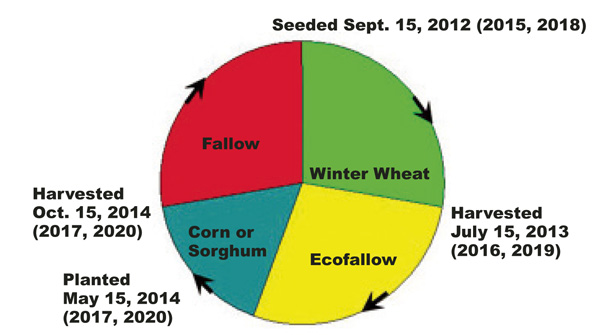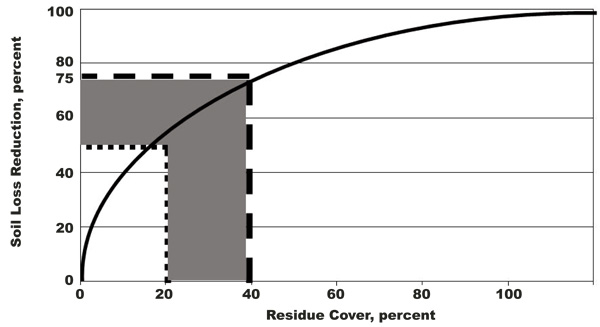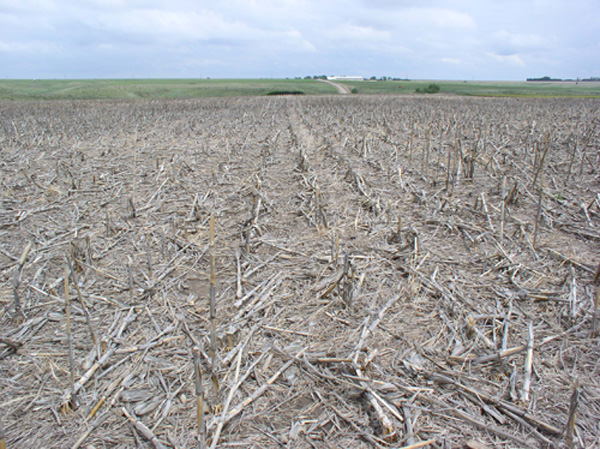G1648
Managing Corn and Grain Sorghum Residues During the Pre-Winter Wheat Fallow Period
This NebGuide explains how to maintain an appropriate residue cover with ecofarming in the pre-winter wheat fallow period to reduce soil erosion and conserve soil moisture.
Robert N. Klein, Extension Western Nebraska Crops Specialist
- Livestock Grazing
- Weed Control
- Seedbed Preparation
- Tillage Implements
- Soil Fertility and Fertilizers
- Summary
Ecofarming is a system of controlling weeds and managing crop residues with minimum use of tillage. It reduces soil erosion and production costs while increasing weed control, water infiltration, moisture conservation, and crop yields. One ecofarming rotation is winter wheat-ecofallow corn or grain sorghum-fallow (Figure 1). Ecofallow is the period between winter wheat harvest and corn or grain sorghum planting. During ecofallow, winter wheat stubble is treated with herbicides to control weeds. Corn or grain sorghum is then no-till planted into the winter wheat stubble. A second fallow period occurs between corn or grain sorghum harvest and the planting of winter wheat. This fallow period, called pre-winter wheat fallow, is the focus of this NebGuide.
 |
| Figure 1. The ecofallow and fallow periods in the three-year ecofarming rotation. |
The pre-winter wheat fallow is often neglected. Maintaining corn or sorghum residues on the soil surface will improve the probability of a successful winter wheat crop because it will improve water infiltration, reduce evaporation and increase the amount of water in the soil at planting. Maintaining adequate crop residue will also greatly reduce soil erosion (Figure 2). For example, a 40 percent residue cover will reduce soil erosion by 75 percent, compared with no residue on the soil surface.
 |
| Figure 2. Relationship between soil surface residue cover and soil erosion. The example shows that a 20 percent residue cover will reduce erosion by 50 percent and a 40 percent residue cover will reduce erosion by 75 percent of that occurring from a cleanly tilled field. |
The goal at the end of the pre-winter wheat fallow season is to have the seedbed in a condition that permits winter wheat seed to be placed in firm, moist soil (Figure 3). The interrow area may be loose, which will delay germination of winter annual weed seeds near the soil surface. Sufficient residues and clods should be left on the surface to retard wind and water erosion before and after the crop is seeded. The amount of residue should not exceed the capabilities of the drill to be used for seeding. Modification and adjustments will make it easier for the drill to work in heavier residue.
 |
| Figure 3. Corn and wheat residue in spring after corn harvest followed with herbicides. |
Livestock Grazing
One way to gain economic return during the pre-winter wheat fallow period is to allow livestock to glean sorghum heads, corn ears, loose leaves, and corn shucks following harvest. Ecofallow corn and sorghum should be pastured only when the fields are dry enough to prevent soil compaction and the burying of weed, sorghum, or corn seeds. Fields are dry enough when soil squeezed in the hand fails to hold its shape. Livestock grazing should be limited to a short period of time because cattle traffic can quickly destroy winter wheat, corn or grain sorghum residues.
Weed Control
Weeds should be controlled on a timely basis while maintaining as much residue as possible. Weeds use large amounts of soil water when they are inadequately controlled during the fallow period, and this may result in spotty stands of wheat (or corn or grain sorghum). Weeds are easiest to control when they are small (less than 4 inches). Waiting for more weeds to emerge can be costly because the larger weeds are not killed easily. For example, delaying control of downy brome reduced winter wheat yields from 40 bu/A to 26 bu/A. Weeds allowed to go to seed will likely increase weed pressure in the subsequent crops, reducing yields or increasing production costs.
Tillage and/or herbicides may be used to control weeds. Weed control tools should be chosen carefully, based on weeds present, the length of control needed, the susceptibility of succeeding crops to herbicide residues, and cost. Herbicide tools are discussed later in this publication. Tillage tools will be discussed in the next section.
The ecofallow rotation has positive effects on weed control. Wheat, corn, and sorghum residues suppress weed growth. A residual herbicide used in the corn or sorghum crop may reduce weed growth in the pre-winter wheat fallow (Table I). Timely herbicide application after wheat harvest affects the density of weeds in the fallow period (Table II). Using the three-year ecofallow rotation normally reduces populations of downy brome, hairy chess, Japanese chess and jointed goatgrass because including corn or grain sorghum in the rotation disrupts the winter annual life cycle and allows additional opportunities to control them with herbicides.
| Table I. Fallow weed growth after atrazine is applied to grain sorghum at North Platte, Neb. | ||
| Sorghum treatment | Rate |
Weed growth in fallowa |
(lb ai/A) |
(lb/A) |
|
| Weedy check | — |
1440 a |
| Hand-weeded check | — |
520 bc |
| Atrazine | 1 |
960 ab |
| Atrazine | 2 |
470 bc |
| aLetters followed by the same letter are not significantly different at the 5 percent level. | ||
| Table II. Effect of delaying herbicide applications after wheat harvest on various weed species during the fallow period after corn, 1979-1981. | |||||
Days after wheat harvest atrazine was applied |
|||||
| Weed Species | 5 |
20 |
35 |
50 |
LSD
0.05 |
----------------- (Plants/m2) -------------------- |
|||||
| Barnyardgrass | 74 |
72 |
60 |
103 |
35 |
| Stinkgrass | 2 |
2 |
4 |
3 |
NS* |
| Witchgrass | 3 |
2 |
2 |
1 |
NS |
| Russian thistle | 10 |
12 |
13 |
13 |
NS |
| Redroot pigweed | 17 |
10 |
6 |
4 |
12 |
| *NS = Not significant at 5% level. | |||||
Winter annual weeds are effectively controlled by several herbicides in March and early April, prior to heading or reproductive growth. These herbicides include glyphosate products, 2,4-D, and others. If weeds are present after corn or sorghum harvest, these should be controlled with the appropriate herbicides.
Emerged summer annual weeds can be controlled by glyphosate or 2,4-D products, Gramoxone Inteon and Glean. A few cautions: Gramoxone Inteon is ineffective on summer annual grass weeds taller than 1 inch. Check Glean labels for use areas and recropping intervals based on your soils. The recropping interval for corn is 24-36 months, and for grain sorghum, 14-36 months, depending on soil pH and cumulative precipitation. Volunteer corn or grain sorghum may escape Glean.
Seedbed Preparation
The goal at the end of the pre-winter wheat fallow period is to have a firm, moist soil for seeding wheat. Sufficient residues should be left on the surface to retard wind and water erosion. However, the amount of residue should not exceed the capabilities of the drill to be used for seeding. In addition, under no-till conditions the surface soil may become so dry and hard that the seeder may be unable to penetrate the soil at wheat seeding.
No-till winter wheat is a possibility if: (1) weeds are adequately controlled with herbicides, (2) a no-till drill will or can be modified to handle heavy crop residue, (3) the residue is well-distributed across the field, or (4) rainfall has been frequent. After one has been in no-till for several years, drill penetration is usually not a problem.
Tillage Implements
Tillage tools should be selected according to the amount of crop residue desired at planting. A good goal is to maintain 40 percent residue cover and reduce soil erosion by 75 percent. Several types of tillage implements may be required to maintain the proper residue amounts (Table III). The kind, quality, quantity, and state of decomposition of the residues, kinds and sizes of weeds, soil moisture condition, soil texture, length of fallow period, and timing of tillage operations should be considered when selecting tillage equipment.
Table III can be used to determine how much residue will remain on the soil surface after specific implements are used. For example, if 90 percent of the soil surface is covered with corn residue in the ecofallow period, only 63 percent will remain after a light disking. The residue cover would be further reduced after operations with a 6-foot blade (.90), rod (.90), rod (.90), and hoe drill (.70), until 32 percent residue cover remains.
Tillage should be delayed in the spring following the corn or sorghum crop until the first crop of weeds emerges. The primary purpose of tillage is to control weeds and to prepare a seedbed for winter wheat seeding. Excess tillage breaks down soil structure and destroys residue. Consequently, the soil is more susceptible to wind and water erosion, surface crusting, and soil compaction. It is important that tillage operations be performed when the weeds can be easily controlled.
With reduced-tillage, a tillage operation should be completed by July 1 even if not needed for weed control. This is to prevent the soil from getting so hard that penetration by tillage equipment or wheat seeders is difficult or impossible in the fall. Hard soil conditions occur with hot, dry weather. Also, shallow tillage at this time reduces the upward movement of soil water to the soil surface where it is lost to evaporation. This helps to maintain moist soil in the seed zone at planting.
| Table III. Amount of crop residue maintained by various primary and secondary tillage tools used for weed control during the fallow period. Also, the wintering effects on crop residue and the residue maintained by wheat seeders. | |
| Operation | Residue maintained after each tillage operation |
| Moldboard plow (5-7 inches deep) | 20% |
| Moldboard plow (8 inches or deeper) | 10% |
| Chisel (twisted points) | 50% |
| Chisel (straight points), 2-inch chisels spaced 12 inches apart | 75% |
| Tandem disk (regular blades) | 50-70% |
| Tandem disk (large blades) | 30-50% |
| One-way disk (24- to 26-inch disks) | 50% |
| Field cultivator (12- to 16-inch sweeps) | 75% |
| Field cultivator (16- to 18-inch sweeps) | 80% |
| Field cultivator plus rod | 75% |
| Mulch treader (spike tooth) | 70% |
| Blades (36 inches or wider) | 90% |
| Sweeps (less than 24 inches) | 80% |
| Sweeps (24 to 36 inches) | 85% |
| Rodweeder plain rod | 90% |
| Rodweeder with semichisel | 85% |
| Harrow | 90% |
| Spring tooth harrow | 75% |
| Fertilizer applicator (injection) | 90% |
| Attachment to tillage equipment such as flextine harrow or mulch treader | 95% |
| Overwintering Corn and sorghum residue Winter wheat residue |
80% 90% |
| Wheat seeder Hoe openers Disk openers |
50-80%
90-95% |
A light disking with a tandem disk may be used to chop the stalks and control weeds when residues are long and poorly distributed. Chisel plows, equipped with chisel and sweeps up to 18 inches wide, can be used instead of a disk in light, well- distributed residue. Some drills may plug with the stalks if a disk is not used. The chisel should be equipped with high clearance shanks spaced to function in heavy residues. A rotary rod, flex harrow or mulch treader mounted behind the last row of chisel shanks will improve weed control, residue distribution, and soil leveling during the first tillage operations. The rod attachment tends to lift residues back to the surface, distribute residues, and on a level soil surface will reduce evaporation of soil water.
Subsurface sweeps, semichisels, rodweeders, and plain rotary rodweeders are the most effective tillage implements for conserving surface residue. Sweep sizes range from 30 inches to 5 to 6 feet. The blade itself is 6 to 8 inches wide, and the V-blade angles vary from 60 to 100 degrees. Wide-angle blades penetrate the soil more easily, but they do not shed weed roots and residues as easily as smaller-angle blades. A blade pitch of about 37 degrees is optimum for soil lift and weed control. A mulch treader attachment can be added to the sweep plow to improve weed control, but mulch treaders should not be used more than once or twice, or the soil may become pulverized and more susceptible to erosion. Rolling coulters at least 20 inches in diameter mounted in front of the sweep (or V-blade) will penetrate heavy residues and weeds.
A rodweeder equipped with semichisels will penetrate firm soil and can be used as a primary or secondary tillage tool. This implement kills weeds better than a plain rod, but it destroys more residue and can plug more in heavy residues than a sweep.
Plain rotary rodweeders are used only for secondary tillage operations. They control small weeds and firm the seedbed prior to seeding, but will not penetrate hard soils. The major disadvantage of all subsurface tillage tools is that weed control is not as good as with the stirring machines (such as the disk), especially in wet, cool soils.
Mulch treaders are used as a second tillage tool to improve weed control after initial tillage, especially when weeds are shallowly rooted. They can also be used to distribute and anchor heavy residues or to firm the seedbed. They tend to pulverize the soil.
Soil Fertility and Fertilizers
Soil sampling and tests should be done early so fertilizer can be applied with tillage. With no-till, much of the fertilizer is applied with application equipment on the drill, although some nitrogen may be top dressed in spring. Soil tests are necessary to ensure proper plant nutrition, minimum fertilizer costs, optimum yields, and quality crop residues.
A good time to apply anhydrous ammonia is with a tillage operation before mid-July. Late July and August applications of anhydrous ammonia, unless used with a rodweeder, may prohibit obtaining a firm seedbed by winter wheat planting. Phosphorus can be applied at the same time if needed. Concentrated bands of anhydrous ammonia and phosphorus have given good yields.
Avoid disturbing the phosphorus band with later tillage operations because phosphorus efficiency will be reduced. A band is more efficient than broadcast. Nitrogen’s efficiency is not affected by tillage; however, excessive rainfall may move the nitrogen below the root zone. In general, band (knife) and seed-applied phosphorus are equal in efficiency except in a dry year when banded (knife) is more efficient since there is a greater probability of having moisture in the area where the phosphorus is located. A nutrient must be in soil solution to be taken up by a plant.
Following is a suggested program for managing weeds in ecofallow corn or sorghum residue in the pre-winter wheat fallow. (See EC130, Guide for Weed Management in Nebraska for additional information and treatment.)
- April: Spray glyphosate or glyphosate + 2,4-D (use 2,4-D for broadleaf weeds that may be resistant to glyphosate or to help prevent broadleaf weeds from becoming resistant to glyphosate) if volunteer wheat and/or downy brome are present.
- If a no-till drill capable of planting through the residues present is used, treating the field with glyphosate + 2,4-D as needed may continue. Always check to determine if a herbicide resistance problem is developing. Take measures to correct the problem. If volunteer Roundup Ready corn is present use an appropriate treatment. See EC130. Take caution if the summer is hot and dry because penetration by the drill may be a problem. Usually after being in no-till several years and good crop residue is present, penetration by the drill is not a problem. If tillage is going to be used, see steps 3, 4, 5, and 6.
- May-June: Use tillage that maintains residue, if needed, for volunteer crops and weed control. A light disking may be needed to chop corn or sorghum stalks.
- Late June: Sweep tillage with anhydrous ammonia and phosphorus placed in 12-inch bands. (If residues are heavy and/or poorly distributed or the seeder cannot plant through the residue, tillage may be needed to reduce the residue.)
- As necessary: Sweep tillage or rodweed to control weeds and prepare a seedbed.
- Final tillage with a rodweed to firm the soil for planting.
Summary
Maintain as much residue on the soil surface as possible during the pre-winter wheat fallow period between corn/sorghum harvest and before winter wheat seeding to reduce soil erosion and improve water conservation. Greater residue levels and good weed control will contribute to a successful ecofallow system. Fallow tillage operations and herbicide treatments must be timely. Often, tillage operations are neglected until weeds are 6 to 12 inches or taller. Multiple tillage operations then are needed to kill them, and crop residues will be destroyed. Weeds remove soil moisture and make it difficult to prepare a good seedbed. Effective fallowing will mean higher winter wheat yields and fewer weeds in the winter wheat stubble to be controlled before the corn or sorghum crop is planted. Ultimately the success of ecofallow corn and sorghum depends on good winter wheat stands.
This publication has been peer reviewed.
Visit the University of Nebraska–Lincoln Extension Publications website for more publications.
Index: Field Crops
Cropping Practices
2006, Revised August 2012